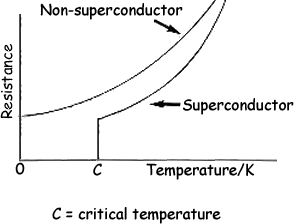Superconductivity 0 degrees Kelvin = -273 degrees Celsius 0K = -273oC
If mercury is cooled below 4.2 K, it loses all electricresistance - it becomes a superconductor. This observation was made by H. Kammerlingh Onnes in 1911. Observations were then made that other metals also exhibit zero resistivity below a certain critical temperature. How do we know the resistance of a superconductor is zero?The fact that the resistance is zero has been shown by the observation that currents in superconducting lead rings remains constant for many years with no measurable reduction in value. Resistance to a current is rather like the friction experienced by a moving object. If there was no friction and you set an object moving it would theoretically continue at the same speed for ever. The same is true with current. Once you set the charge moving it would continue to move at a sateady rate ( constant current). This has been observed in supercooled metals - they become super conductors. An induced current in an ordinary metal ring would decay rapidly from the dissipation of heat energy resulting from ordinary resistance, but superconducting rings have exhibited a 'decay constant' for the current of over a billion years! Critical Temperature
The transition is so sudden and so complete that it appears to be a transition to a different phase of matter. Several materials exhibit superconducting phase transitions at low temperatures. The highest critical temperature was about 23 K until the discovery in 1986 of some high temperature superconductors. The 'high' temperatures are still low (125K is considered 'very high'!). These materials with critical temperatures in the range 120 K have received a great deal of attention because they can be maintained in the superconducting state with liquid nitrogen (77 K).They can therefore have easier practical applications. The surprising thing about them is that they are not metals - but ceramics! (Click here to find out more about them) Applications of superconducting metalsA superconducting electromagnet is an electromagnet that is built using coils of superconducting wire. They must be cooled to cryogenic temperatures during operation. Their advantages are that they can produce stronger magnetic fields than ordinary iron-core electromagnets, and can be cheaper to operate, since no enegy is lost as heat because of ohmic resistance of the windings. During operation, the magnet windings must be cooled below their critical temperature; the temperature at which the winding material changes from the normal resistive state and becomes a superconductor. Liquid helium is used as a coolant for most superconductive coils. Superconducting magnets are widely used in MRI machines, NMR equipment, mass spectrometers, magnetic separation processes, and particle accelerators. They are preferred to ordinary electromagnets because:
Superconducting power cablesHigh-temperature superconductors promise to revolutionize power distribution by providing lossless transmission of electrical power. The development of superconductors with transition temperatures higher than the boiling point of liquid nitrogen has made the concept of superconducting power lines commercially feasible, at least for high-load applications. It has been estimated that the waste would be halved using this method, since the necessary refrigeration equipment would consume about half the power saved by the elimination of the majority of resistive losses. In one hypothetical future system called a SuperGrid, the cost of cooling would be eliminated by coupling the transmission line with a liquid hydrogen pipeline. Superconducting cables are particularly suited to high load density areas such as the business district of large cities, where purchase of an easement for cables (permission to put cables in has to be bought!) would be very costly. Further Reading on this subject
|
Follow me...
|




 The following links take you to the hyperphysics site pages on superconductivity. (These topics are beyond the scope of the AS syllabus - but might well interest you!)
The following links take you to the hyperphysics site pages on superconductivity. (These topics are beyond the scope of the AS syllabus - but might well interest you!) 


